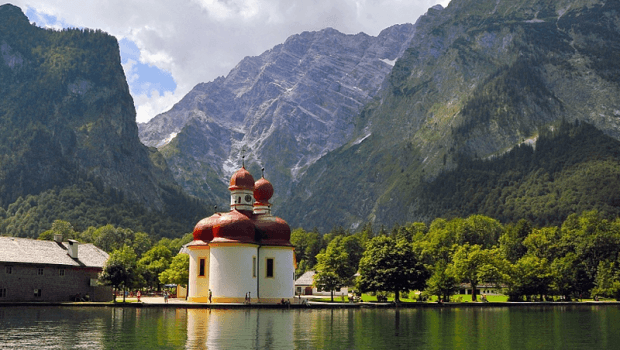
St. Bartholomew’s Church: The German Church on Water
The Roman Catholic church of St. Bartholomew’s is a pilgrimage church. Pilgrims regularly come to visit this church in search of spiritual and moral significances. The German name for St. Bartholomew’s is St. Bartholomä. It is located in Berchtesgadener Land, which is a district in Bavaria, Germany.
St. Bartholomew is named after a Saint Bartholomew the Apostle. Apostles were the closest followers of Jesus and were primarily the preachers of Gospel messages of Jesus. Saint Bartholomew was one of the Jesus’ twelve apostles. Bartholomew has been many times identified with the figure of Nathanael or Nathaniel. St. Bartholomew was the patron of dairymen and alpine farmers.
The church is situated on the western shore of Königssee lake. Königssee is located near the Austrian border, on the Hirschau peninsula, in the interior of Berchtesgaden Alps. This church can only be reached either by hiking across the mountains surrounding it or by a ship. A small point in the north of the region is the only point of entrance.
The Provosts of Berchtesgaden built the first chapel in the year 1134 at the Königssee Lake. The Berchtesgaden Provostry was controlled together by a canonry (a community of priest living together under a particular rule, sharing their assets in common). The priests were part of the Imperial Immediacy, of the Holy Roman Empire, which meant that the priests had a special political and constitutional status, which was deep rooted in the Feudal law of Germany. Though the Rulers of the State had a significant amount of power and rights, they were still below the authority of the Holy Roman Empire.
The chapel was rebuilt in the year 1697 in a Baroque style- a style that started in the latter half of the 16th century in Italy, belonging to the Baroque era. These structures often indicated the victory of the Catholic Churches as they were a mixture of Renaissance architecture with new theatrical and rhetorical fashion. These structures explored new forms of dramatic intensity, light, shadow and form.
The floor plan of the structure was similar to that of Salzburg Cathedral, Austria. Salzburg Cathedral is the Cathedral of Archdiocese of Salzburg and is Roman Catholic. The structure is dedicated to Saint Vergilius and Saint Rupert. St. Bartholomew’s Church has a red roof which is dome shaped and two onion domes (onion domes resemble an onion, their length is bigger than their width). Stucco work is featured on the church which was done by an artist named Joseph Schmidt. Stucco is made up of water, a binder, and coarse particulate material. It is applied when wet and later hardens up when it dries. It was used for decorative coating, usually done on the ceilings and walls, of an architecture.
The church even has three-apse (semicircular recess) Choir. It is where the altar is usually placed or the clergy is seated. Located in the apses, alters are sanctified to Saint Catherine, Saint James, and Saint Bartholomew respectively.
The pilgrimage is held annually on Saturday that comes after 24th of August at St. Bartholomew. The pilgrimage starts from the Maria Alm municipality in the district of Zell am See and across the Alps of Berchtesgaden.
A Jagdschloss (hunting lodge) lies near the chapel which was originally built in the 12th century. Jagdschloss were usually built near a field, forest or lake, and were used by the rulers as accommodation while they are out on a hunting spree. Over the years the lodge near the chapel has been reconstructed several times. The lodge was used as the private residence by the Berchtesgaden Prince-provosts until 1803, but after their territory was combined with the Kingdom of Bavaria in the year 1810, the residence was converted into a lodge for the House of Wittelsbach, who were ruling at that time. Currently, it is used as a hotel.
